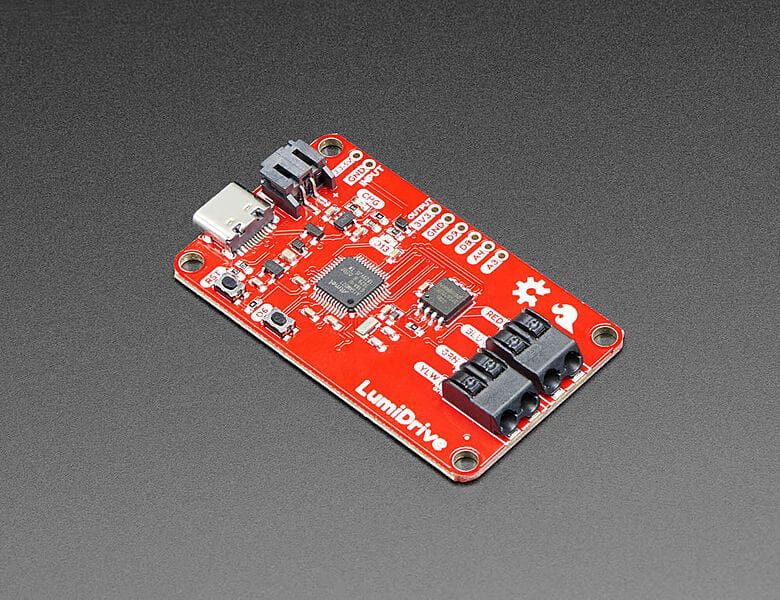
LumiDrive by SparkFun
The LumiDrive LED Driver is SparkFun’s foray into all things Python on micro-controllers. With the SparkFun LumiDrive you will be able to control and personalize a whole strand of APA102s directly from the board itself. We’ve broken out a number of analog and digital pins from the on board SAMD21G-AU microcontroller to incorporate your own external buttons, switches, and other interfaces to interact with your addressable LED strip.
It feels like Arduino, but without the need to upload and compile code. Because the LumiDrive opens up like a USB drive on your computer when you plug it in and the code you write lives directly inside the drive it feels very much like an Arduino-device. The fact that you don’t need to upload and compile code makes it a great transitionary LED driver from your traditional Arduino!
The SparkFun LumiDrive has been equipped with a USB-C connector which is capable enough to supply up to 1.5 Amps from a 3.1 USB port, a LiPo connector and charge circuit for portable power, as well as two poke-home connectors to allow you to plug in wires without the need for solder.
Purchase
Contribute
Have some info to add for this board? Edit the source for this page here.
CircuitPython 10.0.3
This is the latest stable release of CircuitPython that will work with the LumiDrive. Use this release if you are new to CircuitPython.
Modules included in this download
adafruit_pixelbuf analogio array board builtins busdisplay busio busio.SPI busio.UART codeop collections digitalio displayio epaperdisplay errno fontio fourwire i2cdisplaybus locale math microcontroller neopixel_write nvm onewireio os paralleldisplaybus pulseio pwmio rainbowio random rotaryio rtc storage struct supervisor sys terminalio time touchio usb_cdc usb_hid usb_midi warningsIncluded frozen(?) modules: adafruit_dotstar
Features: Battery Charging, USB-C
CircuitPython 10.1.0-beta.1
This is the latest development release of CircuitPython that will work with the LumiDrive.
Alpha development releases are early releases. They are unfinished, are likely to have bugs, and the features they provide may change. Beta releases may have some bugs and unfinished features, but should be suitable for many uses. A Release Candidate (rc) release is considered done and will become the next stable release, assuming no further issues are found.
Please try alpha, beta, and rc releases if you are able. Your testing is invaluable: it helps us uncover and find issues quickly.
Release Notes for 10.1.0-beta.1
Modules included in this download
adafruit_pixelbuf analogio array board builtins busdisplay busio busio.SPI busio.UART codeop collections digitalio displayio epaperdisplay errno fontio fourwire i2cdisplaybus locale math microcontroller neopixel_write nvm onewireio os paralleldisplaybus pulseio pwmio rainbowio random rotaryio rtc storage struct supervisor sys terminalio time touchio usb_cdc usb_hid usb_midi warningsIncluded frozen(?) modules: adafruit_dotstar
Features: Battery Charging, USB-C
Absolute Newest
Every time we commit new code to CircuitPython we automatically build binaries for each board and language. The binaries are stored on Amazon S3, organized by board, and then by language. These releases are even newer than the development release listed above. Try them if you want the absolute latest and are feeling daring or want to see if a problem has been fixed.
Previous Versions of CircuitPython
All previous releases of CircuitPython are available for download from Amazon S3 through the button below. For very old releases, look in the OLD/ folder for each board. Release notes for each release are available at GitHub button below.
Older releases are useful for testing if you something appears to be broken in a newer release but used to work, or if you have older code that depends on features only available in an older release. Otherwise we recommend using the latest stable release.
